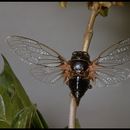Conservation Status
provided by University of Alberta Museums
Status unknown.
- license
- cc-by-nc
- copyright
- University of Alberta Museums
Cyclicity
provided by University of Alberta Museums
Adults emerge in July (Strickland 1953).
- license
- cc-by-nc
- copyright
- University of Alberta Museums
Distribution
provided by University of Alberta Museums
Reported from Lethbridge in Alberta, but likely also occurs in the southwestern mountains, as it occurs throughout southern British Columbia. Found south through Washington, Oregon, Idaho, Montan, Nevada, Utah and California (Davis 1919, Simons 1954, Strickland 1953).
- license
- cc-by-nc
- copyright
- University of Alberta Museums
General Description
provided by University of Alberta Museums
A mid- to large-sized Okanagana with a wingspan of about 60mm. Predominantly shiny black with orange segment borders and markings. O. rimosa is similar and sympatric to occidentalis in the western parts of the province, but occidentalis has a broader forewing (width:length ratio of 0.34 - 0.36, 0.29 - 0.31 in rimosa), and is shiny black rather than the dull black of rimosa. Compared to bella, occidentalis has a dense covering of long hairs on the underside of the abdomen, bella has only sparse, short hairs. The ventral plate of the terminal abdominal segment is doubly notched in female occidentalis, singly in bella (Davis 1919).
- license
- cc-by-nc
- copyright
- University of Alberta Museums
Habitat
provided by University of Alberta Museums
Likely restricted to montane grasslands in Alberta.
- license
- cc-by-nc
- copyright
- University of Alberta Museums
Life Cycle
provided by University of Alberta Museums
Unknown, but undoubtedly similar to other members of the genus.
- license
- cc-by-nc
- copyright
- University of Alberta Museums
Trophic Strategy
provided by University of Alberta Museums
Plant fluids. Specific hosts unknown.
- license
- cc-by-nc
- copyright
- University of Alberta Museums

